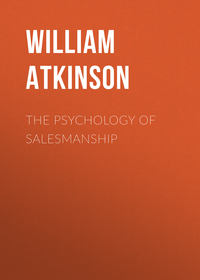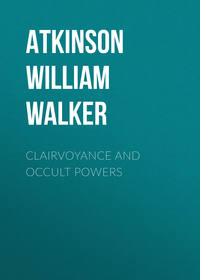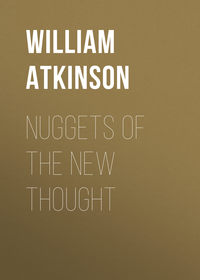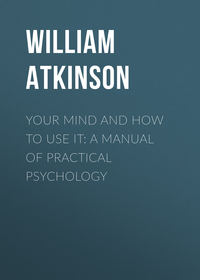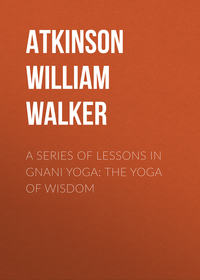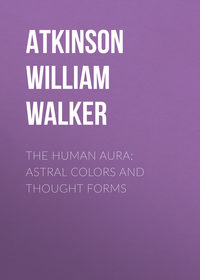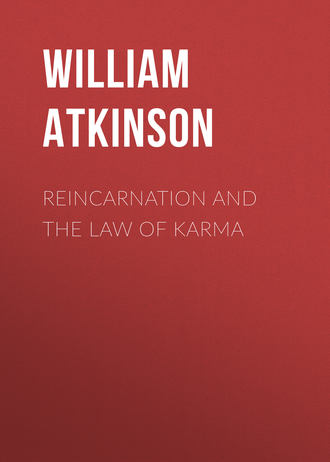 полная версия
полная версияReincarnation and the Law of Karma

William Walker Atkinson
Reincarnation and the Law of Karma / A Study of the Old-New World-Doctrine of Rebirth, and Spiritual Cause and Effect
CHAPTER I
The Early Races
By "Reincarnation" we mean the repeated incarnation, or embodiment in flesh, of the soul or immaterial part of man's nature. The term "Metempsychosis" is frequently employed in the same sense, the definition of the latter term being: "The passage of the soul, as an immortal essence, at the death of the body, into another living body." The term "Transmigration of Souls" is sometimes employed, the term being used in the sense of "passing from one body into another." But the term "Transmigration" is often used in connection with the belief of certain undeveloped races who held that the soul of men sometimes passed into the bodies of the lower animals, as a punishment for their sins committed during the human life. But this belief is held in disrepute by the adherents of Reincarnation or Metempsychosis, and has no connection with their philosophy or beliefs, the ideas having sprung from an entirely different source, and having nothing in common.
There are many forms of belief – many degrees of doctrine – regarding Reincarnation, as we shall see as we proceed, but there is a fundamental and basic principle underlying all of the various shades of opinion, and divisions of the schools. This fundamental belief may be expressed as the doctrine that there is in man an immaterial Something (called the soul, spirit, inner self, or many other names) which does not perish at the death or disintegration of the body, but which persists as an entity, and after a shorter or longer interval of rest reincarnates, or is re-born, into a new body – that of an unborn infant – from whence it proceeds to live a new life in the body, more or less unconscious of its past existences, but containing within itself the "essence" or results of its past lives, which experiences go to make up its new "character," or "personality." It is usually held that the rebirth is governed by the law of attraction, under one name or another, and which law operates in accordance with strict justice, in the direction of attracting the reincarnating soul to a body, and conditions, in accordance with the tendencies of the past life, the parents also attracting to them a soul bound to them by some ties in the past, the law being universal, uniform, and equitable to all concerned in the matter. This is a general statement of the doctrine as it is generally held by the most intelligent of its adherents.
E. D. Walker, a well-known English writer on the subject, gives the following beautiful idea of the general teachings: "Reincarnation teaches that the soul enters this life, not as a fresh creation, but after a long course of previous existences on this earth and elsewhere, in which it acquired its present inhering peculiarities, and that it is on the way to future transformations which the soul is now shaping. It claims that infancy brings to earth, not a blank scroll for the beginning of an earthly record, nor a mere cohesion of atomic forces into a brief personality, soon to dissolve again into the elements, but that it is inscribed with ancestral histories, some like the present scene, most of them unlike it and stretching back into the remotest past. These inscriptions are generally undecipherable, save as revealed in their moulding influence upon the new career; but like the invisible photographic images made by the sun of all it sees, when they are properly developed in the laboratory of consciousness they will be distinctly displayed. The current phase of life will also be stored away in the secret vaults of memory, for its unconscious effects upon the ensuing lives. All the qualities we now possess, in body, mind and soul, result from our use of ancient opportunities. We are indeed 'the heir of all the ages,' and are alone responsible for our inheritances. For these conditions accrue from distant causes engendered by our older selves, and the future flows by the divine law of cause and effect from the gathered momentum of our past impetuses. There is no favoritism in the universe, but all have the same everlasting facilities for growth. Those who are now elevated in worldly station may be sunk in humble surroundings in the future. Only the inner traits of the soul are permanent companions. The wealthy sluggard may be the beggar of the next life; and the industrious worker of the present is sowing the seeds of future greatness. Suffering bravely endured now will produce a treasure of patience and fortitude in another life; hardships will give rise to strength; self-denial must develop the will; tastes cultivated in this existence will somehow bear fruit in coming ones; and acquired energies will assert themselves whenever they can by the Law of Parsimony upon which the principles of physics are based. Vice versa, the unconscious habits, the uncontrollable impulses, the peculiar tendencies, the favorite pursuits, and the soul-stirring friendships of the present descend from far-reaching previous activities."
The doctrine of Reincarnation – Metempsychosis – Rebirth – has always been held as truth by a large portion of the human race. Following the invariable law of cyclic changes – the swing of the pendulum of thought – at times it has apparently died out in parts of the world, only to be again succeeded by a new birth and interest among the descendants of the same people. It is a light impossible to extinguish, and although its flickering flame may seem to die out for a moment, the shifting of the mental winds again allows it to rekindle from the hidden spark, and lo! again it bursts into new life and vigor. The reawakened interest in the subject in the Western world, of which all keen observers have taken note, is but another instance of the operation of the Cyclic Law. It begins to look as if the occultists are right when they predict that before the dawn of another century the Western world will once more have embraced the doctrines of Rebirth – the old, discarded truth, once so dear to the race, will again be settled in popular favor, and again move toward the position of "orthodox" teaching, perhaps to be again crystallized by reason of its "orthodoxy" and again to lose favor and fade away, as the pendulum swings backward to the other extreme of thought.
But the teaching of Reincarnation never has passed away altogether from the race – in some parts of the world the lamp has been kept burning brightly – nay, more, at no time in human history has there been a period in which the majority of the race has not accepted the doctrine of Rebirth, in some of its various forms. It was so one thousand years ago – two thousand – five thousand – and it is so to-day. In this Twentieth Century nearly if not quite two-thirds of the race hold firmly to the teaching, and the multitudes of Hindus and other Eastern peoples cling to it tenaciously. And, even outside of these people, there are to be found traces of the doctrine among other races in the East, and West. So Reincarnation is not a "forgotten truth," or "discarded doctrine," but one fully alive and vigorous, and one which is destined to play a very important part in the history of Western thought during the Twentieth Century.
It is interesting to trace the history of the doctrine among the ancient peoples – away back into the dim recesses of the past. It is difficult to ascribe to any particular time, or any particular race, the credit of having "originated" Reincarnation. In spite of the decided opinions, and the differing theories of the various writers on this subject, who would give Egypt, or India, or the lost Atlantis, as the birthplace of the doctrine, we feel that such ideas are but attempts to attribute a universal intuitive belief to some favored part of the race. We do not believe that the doctrine of Reincarnation ever "originated" anywhere, as a new and distinct doctrine. We believe that it sprang into existence whenever and wherever man arrived at a stage of intellectual development sufficient to enable him to form a mental conception of a Something that lived after Death. No matter from what source this belief in a "ghost" originated, it must be admitted that it is found among all peoples, and is apparently an universal idea. And, running along with it in the primitive peoples, we find that there is, and always has been, an idea, more or less vague and indistinct, that somehow, someway, sometime, this "ghost" of the person returns to earthly existence and takes upon itself a new fleshly garment – a new body. Here, then, is where the idea of Reincarnation begins – everywhere, at a certain stage of human mental development. It runs parallel with the "ghost" idea, and seems bound up with that conception in nearly every case. When man evolves a little further, he begins to reason that if the "ghost" is immortal, and survives the death of the body, and returns to take upon itself a new body, then it must have lived before the last birth, and therefore must have a long chain of lives behind it. This is the second step. The third step is when man begins to reason that the next life is dependent upon something done or left undone in the present life. And upon these three fundamental ideas the doctrine of Reincarnation has been built. The occultists claim that in addition to this universal idea, which is more or less intuitive, the race has received more or less instruction, from time to time, from certain advanced souls which have passed on to higher planes of existence, and who are now called the Masters, Adepts, Teachers, Race Guides, etc., etc. But whatever may be the explanation, it remains a truth that man seems to have worked out for himself, in all times and in all places, first, an idea of a "ghost" which persists after the body dies; and second, that this "ghost" has lived before in other bodies, and will return again to take on a new body. There are various ideas regarding "heavens" and "hells," but underlying them all there persists this idea of re-birth in some of its phases.
Soldi, the archaeologist, has published an interesting series of works, dealing with the beliefs of primitive peoples, who have passed from the scene of human action. He shows by the fragments of carving and sculpture which have survived them that there was an universal idea among them of the "ghost" which lived after the body died; and a corresponding idea that some day this "ghost" would return to the scene of its former activities. This belief sometimes took the form of a return into the former body, which idea led to the preservation of the body by processes of mummifying, etc., but as a rule this belief developed into the more advanced one of a re-birth in a new body.
The earlier travelers in Africa have reported that here and there they found evidences and traces of what was to them "a strange belief" in the future return of the soul to a new body on earth. The early explorers of America found similar traditions and beliefs among the Red Indians, survivals of which exist even unto this day. It is related of a number of savage tribes, in different parts of the world, that they place the bodies of their dead children by the roadside, in order that their souls may be given a good chance to find new bodies by reason of the approaching of many traveling pregnant women who pass along the road. A number of these primitive people hold to the idea of a complex soul, composed of several parts, in which they resemble the Egyptians, Hindus, Chinese, and in fact all mystical and occult philosophies. The Figi Islanders are said to believe in a black soul and a white soul, the former of which remains with the buried body and disintegrates with it, while the white soul leaves the body and wanders as a "ghost," and afterward, tiring of the wandering, returns to life in a new body. The natives of Greenland are said to believe in an astral body, which leaves the body during sleep, but which perishes as the body disintegrates after death; and a second soul which leaves the body only at death, and which persists until it is reborn at a later time. In fact, the student finds that nearly all of the primitives races, and those semi-civilized, show traces of a belief in a complex soul, and a trace of doctrine of Reincarnation in some form. The human mind seems to work along the same lines, among the different races – unless one holds to the theory that all sprang from the same root-race, and that the various beliefs are survivals of some ancient fundamental doctrine – the facts are not disturbed in either case.
In the last mentioned connection, we might mention that the traditions concerning Ancient Atlantis – the lost continent – all hold to the effect that her people believed strongly in Reincarnation, and to the ideas of the complex soul. As the survivors of Atlantis are believed to have been the ancestors of the Egyptians on the one hand, and of the Ancient Peruvians on the other – the two branches of survivors having maintained their original doctrines as modified by different environments – we might find here an explanation of the prevalence of the doctrine on both sides of the ocean. We mention this merely in passing, and as of general interest in the line of our subject.
CHAPTER II
The Egyptians, Chaldeans, Druids, Etc
After considering the existence of the doctrines of Reincarnation among the primitive peoples, and its traditional existence among the vanished peoples of the past, we find ourselves irresistibly borne toward that ancient land of mystery – the home of the mystics and occultists of the past – the land of Isis – the home of the builders of the Pyramids – the people of the Sphinx. Whether these people were the direct descendants of the people of destroyed Atlantis, the home of the Ancient Wisdom – or whether they were a new people who had rediscovered the old doctrines – the fact remains that when tracing back any old occult or mystic doctrine we find ourselves gradually led toward the land of the Sphinx as the source of that hidden truth. The Sphinx is a fit emblem of that wonderful race – its sealed lips seem to invite the ultimate questions, and one feels that there may be a whispered answer wafted from those tightly closed lips toward the ear that is prepared to hear and receive it. And so, in our search for the origin of Reincarnation, we find ourselves once more confronting the Egyptian Sphinx as we have done so often before in our search after Truth.
Notwithstanding its obvious prehistoric origin, many have claimed that Metempsychosis has its birthplace in old Egypt, on the banks of the Nile. India disputes this claim, holding that the Ganges, not the Nile, gave birth to the doctrine. Be that as it may, we shall treat the Egyptian conception at this place, among the ancient lands holding the doctrine, for in India it is not a thing of the past, but a doctrine which has its full flower at the present time, and which flower is sending forth its subtle odor to all parts of the civilized world. And so we shall defer our consideration of India's teachings until we reach the present stage of the history of Reincarnation. Herodotus, many centuries ago, said of the Egyptians that: "The Egyptians are the first who propounded the theory that the human soul is imperishable, and that where the body of any one dies it enters into some other body that may be ready to receive it; and that when it has gone the round of all created forms on land, in water, and in air, then it once more enters the human body born for it; and that this cycle of existence for the soul takes place in three thousand years."
The doctrine of Reincarnation is discernible though hidden away amidst the mass of esoteric doctrine back of the exoteric teachings of the Egyptians, which latter were expounded to the common people, while the truth was reserved for the few who were ready for it. The inner circles of the Egyptian mystics believed in and understood the inner truths of Reincarnation, and although they guarded the esoteric teachings carefully, still fragments fell from the table and were greedily taken up by the masses, as we may see by an examination of the scraps of historical records which have been preserved, graven in the stone, and imprinted on the bricks. Not only did these people accept the doctrine of Reincarnation, but Egypt was really the home of the highest occult teachings. The doctrines and teachings regarding several "sheaths" or "bodies" of man, which are taught by occultists of all times and races, are believed to have been fully taught in their original purity on the banks of the Nile, and in the shadow of the Pyramids – yes, even before the days of the Pyramids. Their forty centuries of history saw many modifications of the philosophical and religious beliefs, but the fundamental doctrine of Reincarnation was held to during the entire period of history in Ancient Egypt, and was not discarded until the decadent descendants of the once mighty race were overwhelmed by stronger races, whose religions and beliefs superseded the vestiges of the Ancient Doctrine. The Egyptians held that there was "Ka," the divine spirit in man; "Ab," the intellect or will; "Hati," the vitality; "Tet," the astral body; "Sahu," the etheric double; and "Xa," the physical body (some authorities forming a slightly different arrangement), which correspond to the various "bodies of man" as recognized by occultists to-day.
The Ancient Chaldeans also taught the doctrine of Rebirth. The body of Persian and Chaldean mystics and occultists, known as "the Magi," who were masters of the Hidden Wisdom, held to the doctrine of Reincarnation as one of their fundamental truths. In fact, they managed to educate the masses of their people to a much higher point than the masses of the Egyptians, and, escaping the idolatrous tendencies of the Egyptian populace, they manifested a very high degree of pure philosophical, occult, and religious knowledge. The Magi taught that the soul was a complex being, and that certain portions of it perished, while certain other parts survived and passed on through a series of earth and "other-world" existences, until finally it attained such a degree of purity that it was relieved of the necessity for further incarnation, and thenceforth dwelt in the region of ineffable bliss – the region of light eternal. The teaching also held that just before entering into the state of bliss, the soul was able to review its previous incarnations, seeing distinctly the connection between them, and thus gaining a store of the wisdom of experience, which would aid it in its future work as a helper of future races which would appear on the face of the earth. The Magi taught that as all living things – nay, all things having existence, organic or inorganic – were but varying manifestations of the One Life and Being, therefore the highest knowledge implied a feeling of conscious brotherhood and relationship toward and with all.
Even among the Chinese there was an esoteric teaching concerning Reincarnation, beneath the outer teaching of ages past. It may be discerned in the teachings of the early philosophers and seers of the race, notably in the work of Lao-Tze, the great Chinese sage and teacher. Lao-Tze, whose great work, the "Tao-Teh-King," is a classic, taught Reincarnation to his inner circle of students and adherents, at least so many authorities claim. He taught that there existed a fundamental principle called "Tao," which is held to have been identical with the "primordial reason," a manifestation of which was the "Teh," or the creative activity of the universe. From the union and action of the "Tao" and the "Teh" proceeded the universe, including the human soul, which he taught was composed of several parts, among them being the "huen," or spiritual principle; and the "phi," or semi-material vital principle, which together animate the body. Lao-Tze said: "To be ignorant that the true self is immortal, is to remain in a grievous state of error, and to experience many calamities by reason thereof. Know ye, that there is a part of man which is subtle and spiritual, and which is the heaven-bound portion of himself; that which has to do with flesh, bones, and body, belongs to the earth; earthly to earth – heavenly to heaven. Such is the Law." Some have held that Lao-Tze taught the immediate return of the "huen" to the "tao" after death, but from the writings of his early followers it may be seen that he really taught that the "huen" persisted in individual existence, throughout repeated incarnations, returning to the "tao" only when it had completed its round of experience-life. For instance, in the Si Haei, it is said that: "The vital essence is dispersed after death together with the body, bones and flesh; but the soul, or knowing principle of the self, is preserved and does not perish. There is no immediate absorption of the individuality into the Tao, for individuality persists, and manifests itself according to the Law." And Chuang-Tze said: "Death is but the commencement of a new life." It was also taught by the early Taoists, that the deeds, good and evil, of the present life would bear fruit in future existences; in addition to the orthodox heavens and hells, in which the Chinese believed, and of which they had a great variety adapted to the requirements of the various grades of saints and sinners, the minute details of which places being described with that attention to minor details and particulars peculiar to the Chinese mind. The teachings of a later date, that the soul of the ancestor abided in the hall of the ancestors, etc., were a corruption of the ancient teaching. Other Chinese teachers taught that the soul consists of three parts, the first being the "kuei," which had its seat in the belly, and which perished with the body; the second being the "ling," which had its seat in the heart or chest, and which persisted for some time after death, but which eventually disintegrated; and the third, or "huen," which had its seat in the brain, and which survived the disintegration of its companions, and then passed on to other existences.
As strange as it may appear to many readers unfamiliar with the subject, the ancient Druids, particularly those dwelling in ancient Gaul, were familiar with the doctrine of Reincarnation, and believed in its tenets. These people, generally regarded as ancient barbarians, really possessed a philosophy of a high order, which merged into a mystic form of religion. Many of the Romans, upon their conquest of Gallia, were surprised at the degree and character of the philosophical knowledge possessed by the Druids, and many of them have left written records of the same, notably in the case of Aristotle, Cæsar, Lucan, and Valerius Maximus. The Christian teachers who succeeded them also bore witness to these facts, as may be seen by reference to the works of St. Clement, St. Cyril, and other of the early Christian Fathers. These ancient "barbarians" entertained some of the highest spiritual conceptions of life and immortality – the mind and the soul. Reynaud has written of them, basing his statements upon a careful study of the ancient beliefs of this race: "If Judea represents in the world, with a tenacity of its own the idea of a personal and absolute God; if Greece and Rome represent the idea of society, Gaul represents, just as particularly, the idea of immortality. Nothing characterized it better, as all the ancients admit. That mysterious folk was looked upon as the privileged possessor of the secrets of death, and its unwavering instinctive faith in the persistence of life never ceased to be a cause of astonishment, and sometimes of fear, in the eyes of the heathen." The Gauls possessed an occult philosophy, and a mystic religion, which were destroyed by the influences of the Roman Conquest.
The philosophy of the Druids bore a remarkable resemblance to the Inner Doctrine of the Egyptians, and their successors, the Grecian Mystics. Traces of Hermeticism and Pythagoreanism are clearly discernible, although the connecting link that bound them together has been lost to history. Legends among the Druids connected their order with the ancient Aryan creeds and teachings, and there seems to have been a very close connection between these priests and those of Ancient Greece, for there are tales of offerings being sent to the temples of Greece from the priests of Gaul. And it is also related that on the island of Delphos there was once a Druidic tomb in the shape of a monument, believed to have been erected over the remains of Druid priestesses. Herodotus and others speak of a secret alliance between the priests of Greece and those of the Druids. Some of the ancient legends hold that Pythagoras was the instructor of the Druidic priests, and that Pythagoras himself was in close communication with the Brahmins of India, and the Hermetists of Egypt. Other legends have it that the Druids received their first instruction from Zamolais, who had been a slave and student of Pythagoras. At any rate, the correspondence between the two schools of philosophy is remarkable.


